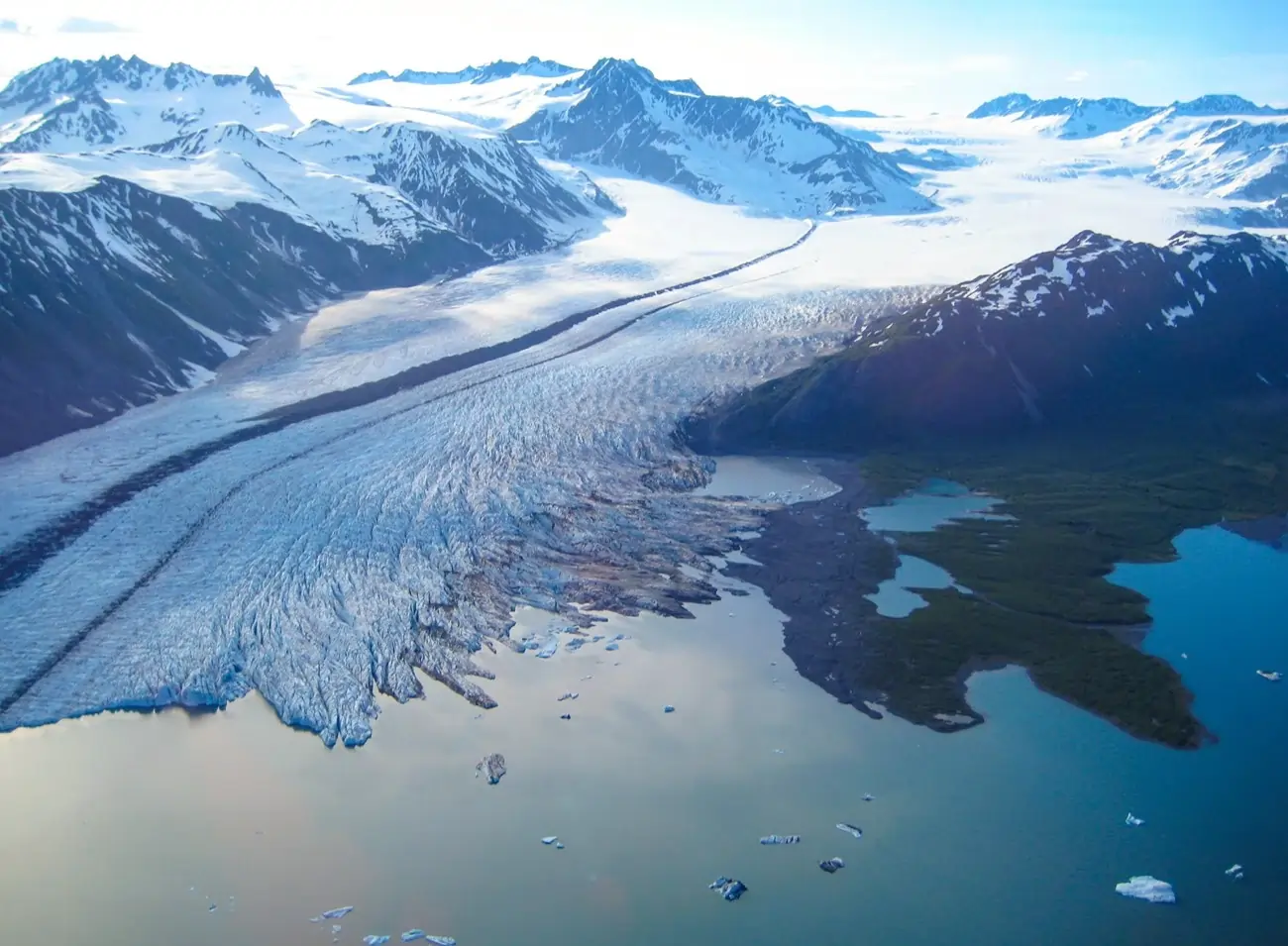⫸ Introduction
Glaciers shape mountains and coastlines, playing a crucial role in our planet‘s climate. But how are these icy behemoths created? If you’ve ever wondered, let’s dive into the fascinating world of glacier formation.
⫸ How are Glaciers Formed?
Glaciers, often called “rivers of ice,” are awe-inspiring natural wonders. But how are glaciers formed? The process starts with simple snowfall and culminates in massive moving bodies of ice that shape our landscapes. Let’s break down this incredible transformation of snow into glacial ice.
Snowfall and Accumulation
It begins with the right kind of snow – dry, fluffy snow accumulating over long periods. This snowfall often occurs in regions with cold winters and relatively cool summers, where snowpacks don’t completely melt yearly.
Firn Formation
As layers of snow build-up, older layers get buried and compressed. Air gets squeezed out, and the snowflakes recrystallize into denser, granular snow called firn. Think of firn as the intermediate stage between fluffy snow and solid ice.
Glacial Ice
Continuous pressure from accumulating snow and firn transforms the firn into incredibly dense glacial ice. Glacial ice has a characteristic blue tint due to how light is absorbed and scattered. This signals the final stage of transformation.
The Critical Threshold
Once the ice becomes thick enough (usually around 50 meters), its immense weight triggers a crucial point. The glacier begins to move, flowing slowly under its weight and the force of gravity. This movement marks the true birth of a glacier.
⫸ Glacier Movement
Glaciers might look like frozen, static features, but the truth is far more dynamic. This vast mass of ice constantly moves, reshaping the landscape under immense weight and pressure. Let’s delve into the mechanisms behind glacier movement.
Internal Deformation
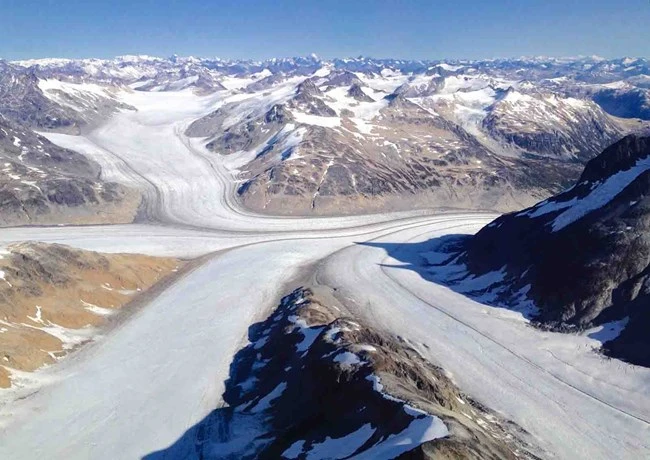
Ice may seem solid, but at a molecular level, it behaves like a very thick liquid. Individual ice crystals within a glacier slowly deform and change shape under the pressure of the overlying ice. This gradual change allows the glacier to flow downhill, even on gentle slopes.
Basal Sliding
A thin layer of meltwater can act as a lubricant at the glacier’s base. This decreases friction between the ice and the bedrock, allowing the glacier to slide downhill more easily. Meltwater production can increase with warmer temperatures, speeding up glacier movement.
Factors Influencing Speed
Glacier movement isn’t uniform. Several factors dictate a glacier’s speed: Terrain (Steeper slopes lead to faster flow), temperature (Warmer temperatures increase meltwater and movement), and ice thickness (Thicker ice exerts greater pressure, leading to faster flow).
Types of Glacier Flow
Glaciers move in different ways: Creep is the slow, continuous internal deformation. Surges are sudden, rapid advances that can dramatically alter a glacier’s length. Other modes of flow exist, reflecting the complex forces that drive these icy giants.
⫸ Types of Glaciers
Glaciers aren’t just monolithic blocks of ice. Their location varies with where they are formed. They come in a fascinating array of shapes and sizes, each playing a distinct role in shaping our planet. Let’s explore some of the most common types of glaciers:

Continental Glaciers
These are the true behemoths of the ice world, blanketing vast landmasses. The Greenland and Antarctic ice sheets are prime examples, covering nearly entire continents.
Valley Glaciers
Picture a slow-moving river of ice nestled within a mountain valley. Valley glaciers form in high-altitude areas and flow downhill, carving out iconic U-shaped valleys. Alaska’s stunning Fraser Glacier is a classic example.
Piedmont Glaciers
When valley glaciers spill out onto flatter plains, they form broad, fan-shaped piedmont glaciers. The Malaspina Glacier in Alaska is a breathtaking example of this type.
Ice Sheets
Similar to continental glaciers but smaller in scale, ice sheets are massive expanses of ice covering large areas like Iceland.
Ice Caps
Ice caps, which resemble a dome of ice, cover mountaintops or plateaus. Vatnajökull in Iceland is a well-known ice cap.
⫸ Landforms Created by Glaciers
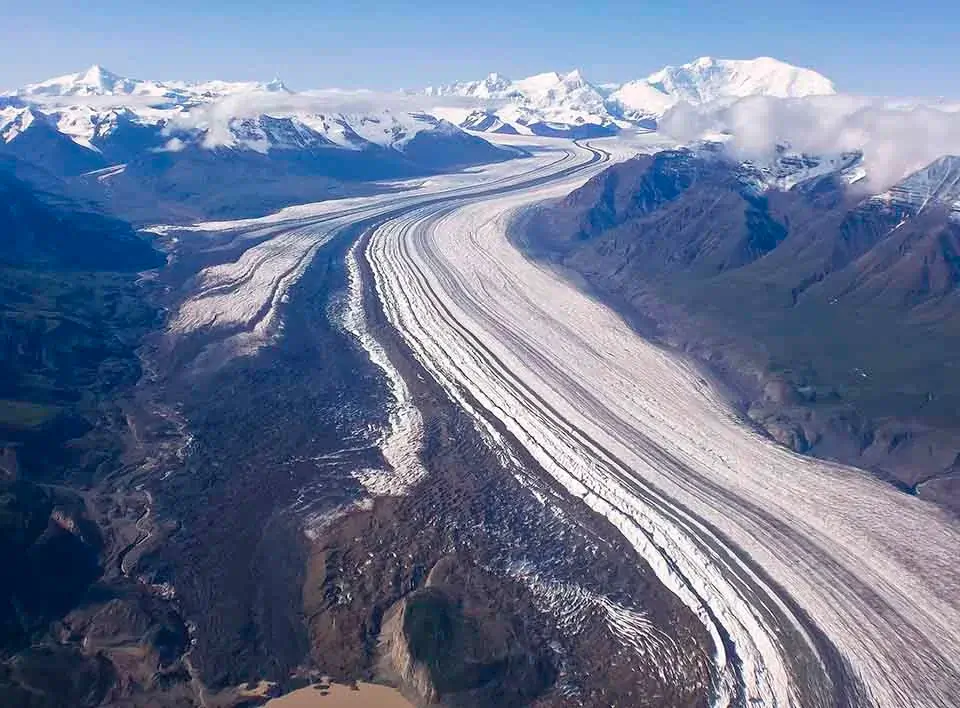
Glaciers don’t just form; they become powerful sculptors of the landscape. Their immense weight and relentless movement carve and reshape the Earth, leaving distinctive landforms that tell the story of their icy journey. Let’s explore some of the most common glacial landforms.
Erosional Landforms
● Cirques, U-shaped Valleys, Arêtes
- Cirques are bowl-shaped depressions carved at the head of glaciers. As the ice plucks rock away, they create steep back walls. Examples are Summit Lake and Great Gulf, US.
- U-shaped valleys are formed as glaciers gouge out troughs, leaving a broad, rounded profile. Examples are Yosemite Valley and Nant Ffrancon Valley in Snowdonia, Wales.
- Arêtes are sharp, knife-like ridges between two glacial valleys. Examples are The jagged Garden Wall of Glacier National Park (Montana) and the Half Dome of Yosemite National Park (California).
● Hanging Valleys, Fjords
- Hanging valleys form where smaller tributary glaciers once met a larger one. When the ice melts, a dramatic ‘step’ remains. Examples – Yosemite Falls and Bridal Veil Falls in Yosemite National Park, California.
- Fjords are long, deep coastal inlets formed when glaciers carve valleys that later flood with seawater. Example: Naeroyfjord, Norway (fjord)
Depositional Landforms
● Moraines (lateral, terminal, medial)
Moraines are piles of rocky debris. Lateral moraines form along the glacier’s edges; terminal moraines mark the furthest advance, and medial moraines form where two glaciers merge. An example is Long Island, New York (terminal moraine).
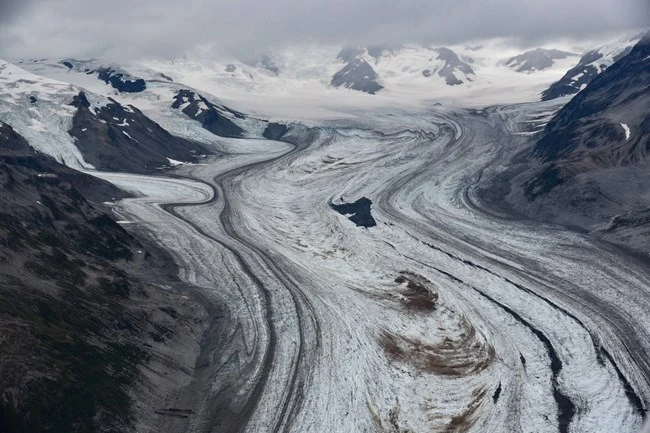
● Drumlins, Eskers
- Drumlins are smooth, teardrop-shaped hills of sediment deposited beneath the glacier. Example – Clew Bay, Ireland, and George’s Island in Halifax Harbour, Canada.
- Eskers are long, winding ridges of sand and gravel left behind by meltwater streams within or below the ice. Example: Great Esker Park in Weymouth, Massachusetts and Uppsala Sen in Sweden.
⫸ Importance of Glaciers
Glaciers might seem like distant, icy realms, but they play vital roles in Earth’s interconnected systems. Here’s why understanding how glaciers are formed also helps us grasp their significance:
● Freshwater Reservoirs
● Climate Regulators
Glacier’s bright surfaces reflect sunlight, helping regulate temperatures. Their loss contributes to warming (e.g., accelerated melting of Greenland’s ice sheet).
● Sea Level Guardians
Glacier melt directly affects sea levels. If all land ice melted, oceans could rise by over 70 meters! (e.g., Antarctic ice melt is a major concern).
● Unique Habitats
Glaciers host specialized lifeforms, from ice worms to microbes, contributing to biodiversity.
⫸ Glaciers and Climate Change: A Melting Crisis
Glaciers, often seen as timeless symbols of nature’s power, are facing a dire threat due to climate change. The accelerated melting of glaciers is a stark indicator of the planet’s warming, and the consequences are far-reaching.
Rising Temperature
Our planet’s average temperature is rising primarily due to human activities that release greenhouse gases like carbon dioxide. These gases trap heat, causing a warming effect. As temperatures climb, glaciers experience a negative mass balance. This means they’re losing more ice through melting than they’re gaining from snowfall.
Glacial Retreat
Worldwide, glaciers are receding at alarming rates. Iconic glaciers like those in the Alps or the massive ice sheets of Greenland are shrinking, with many smaller glaciers disappearing entirely. This retreat is primarily due to rising temperatures that trigger increased melting.
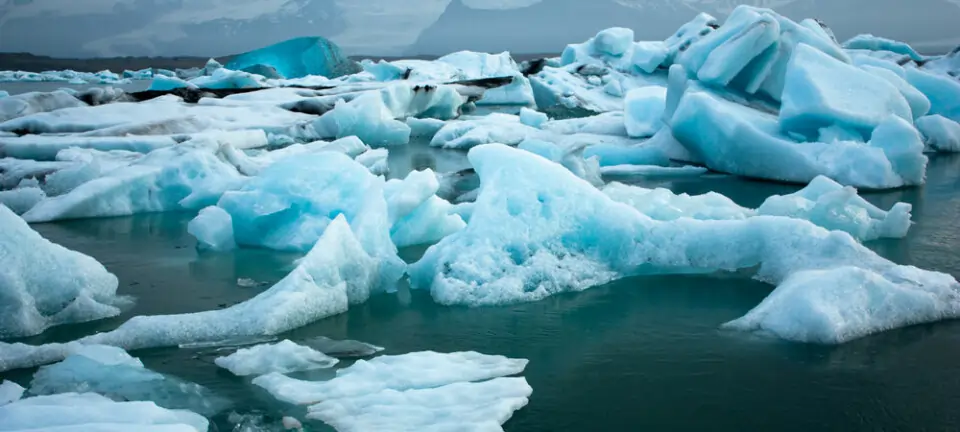
Impacts of Glacial Retreat
● Sea Level Rise
As glaciers melt, they release vast amounts of water into the oceans, contributing significantly to rising sea levels. This threatens coastal communities worldwide with flooding and erosion. For example, island nations like the Maldives are at severe risk of being inundated.
● Water Supply Disruptions
Glaciers act as natural reservoirs, providing crucial water sources for many regions. Melting glaciers disrupt the seasonal meltwater flow, leading to water shortages for drinking, agriculture, and hydropower. Regions like the Andes in South America are particularly vulnerable.
● Loss of Biodiversity
Glacial ecosystems harbor unique and specialized life forms. As glaciers shrink, these habitats are lost, leading to species decline and even extinction. Cold-water species like the Arctic char are examples of wildlife directly threatened by glacial retreats.
● Intensified Climate Change
Melting glaciers expose darker surfaces beneath, which absorb more heat, accelerating warming in a vicious cycle.
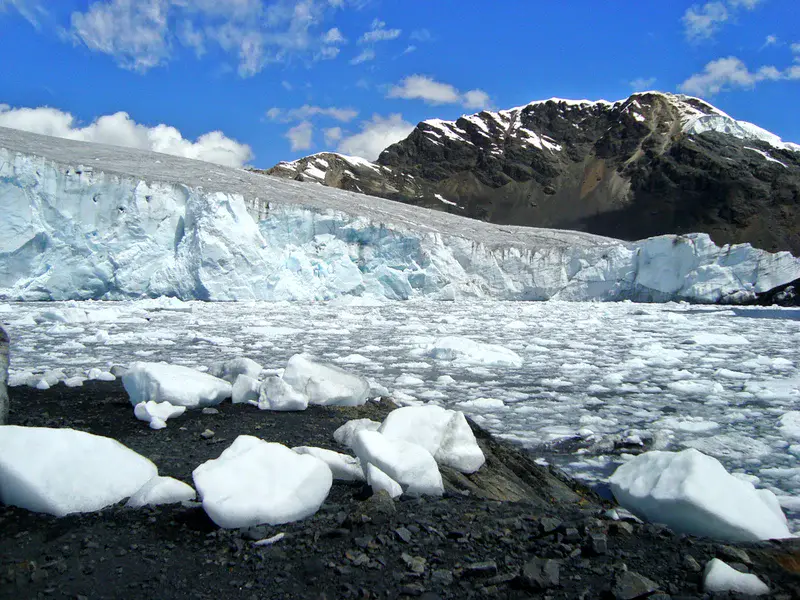
● Disruption of Weather Patterns
Glaciers regulate global temperatures. Their retreat can alter atmospheric circulation patterns and contribute to more extreme weather events.
The Urgency of Action
- Curbing Emissions: Reducing greenhouse gas emissions through sustainable practices and transitioning to renewable energy sources is crucial. Reducing our reliance on fossil fuels is also critical to slowing global warming.
- Glacier Restoration Projects: While large-scale efforts are complex, some initiatives involve covering vulnerable glacial surfaces with reflective materials to minimize melting.
- Additionally, research on glacier behavior and mitigation strategies can help us adapt to the changing environment.
⫸ Conclusion
In this exploration of glacier formation, we’ve uncovered the extraordinary steps that transform snowfall into vast, moving masses of ice. Glaciers begin with persistent snowfall that doesn’t melt away completely. This snow accumulates, compressing into firn, then finally into dense glacial ice. When enough ice builds up, its sheer weight triggers a slow, relentless flow.
Glaciers are more than just stunning landscapes. They act as massive freshwater reservoirs, influencing ocean currents, regulating global temperatures, and providing vital water sources for ecosystems and human communities.
Sadly, climate change is accelerating glacier melt worldwide. We must take urgent action to protect these icy wonders and preserve our planet’s delicate balance. Reducing greenhouse gas emissions is crucial to slowing glacial retreat and safeguarding the many benefits glaciers provide.
Collective action is crucial to protect these ancient giants and ensure a healthier planet for future generations.

